Keto Diet For Beginners
Get a keto diet for beginners guide that will take you by the hand, teaching you everything you need to know about the ketogenic diet. Meal plan included with checklist and mindmap.
- Benefits of the Keto Diet
- Keto Diet For Beginners – How to start
- What are the best foods to eat on a ketogenic diet?
- Foods to Avoid on a Ketogenic Diet
- How Do I Calculate My Macros For Keto?
- What is a typical keto meal plan for beginners?
- Quick And Easy Keto Recipes
- Is the ketogenic diet safe for diabetics?
- Can I Follow A Keto Diet While Pregnant?
- Keto Diet For Beginners -The Risks
- Keto Diet For Beginners – Mistakes to Avoid
- How to Monitor Your Progress on the Keto Diet For Beginners
- Dealing With Keto Flu

What is the Keto Diet?
The ketogenic diet is better known to most as the keto diet. One of the main features of this diet is that it’s a low-carb, high-fat diet that works by shifting the body’s metabolism away from carbohydrates and towards fat as the primary energy source.
On this diet, one experiences a significant reduction in carbohydrate intake while increasing the consumption of fats and moderating protein intake.

Typically, the macronutrient ratios for this meal plan consist of approximately 70% fats, 25% proteins, and only 5% carbohydrates. The body is thus induced into a metabolic state known as ketosis by adhering to this specific distribution of macronutrients.
How does the keto diet work?
When the body is deprived of sufficient carbohydrates, it utilizes the fat stores for energy conversion. This is the state of Ketosis. In this state, the liver transforms fatty acids into ketones, which serve as an alternative fuel source for the brain and other tissues. That is the basic idea of how the ketogenic diet works.
keto Diet For Beginners – What To Expect
Burning fat is one of the natural expected outcomes for someone on the ketogenic diet, but not only that; it also aids in the reduction of body fat percentage over time. Besides the positive weight loss, this diet has garnered attention for its other potential health benefits.
Some of these health benefits include improved insulin levels, stabilized blood pressure, and support for individuals with type 2 diabetes. If you’re interested in a keto diet for beginners, take a short quiz and find out how much weight you can lose with this keto meal plan.
History Of the Keto Diet
The ketogenic diet emerged in the early 20th century when it was initially developed as a treatment for epilepsy. It has become very popular among people desirous of refining their dietary habits, especially as a diet for beginners aiming to lose weight or improve their overall health.
Despite the prevalence of processed foods and high-carb options in modern diets, those following the ketogenic method prioritize whole foods rich in healthy fats, such as avocado oil, and olive oil, alongside lean protein sources.
This strategic approach not only supports consistent energy levels but promotes sustainable weight loss in alignment with the benefits of the keto diet. Find out how you can burn fat and earn here.
Benefits of the Keto Diet
- Weight loss
- Improved Mental Clarity:
- Increased Energy:
Because this state of ketosis shifts the body from carbohydrates to fat for energy, this strategy allows increased fat-burning and potential weight loss.
Compared to glucose derived from carbohydrate-heavy meals, ketones are a more efficient fuel for the brain leading to better focus and mental clarity. This leads to better productivity.
With a steady energy supply from fat, many people report improved stamina and endurance.
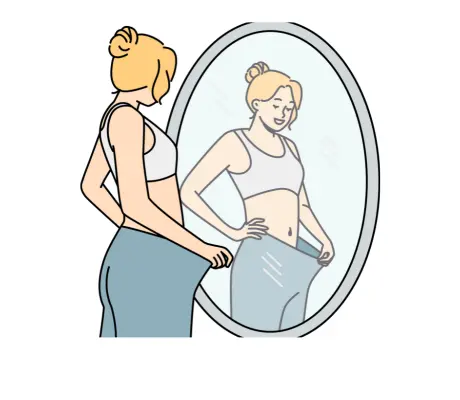
- Helps blood sugar and blood pressure levels:
- Reduced Inflammation:
The ketogenic diet has shown promise in potentially lowering blood pressure and stabilizing insulin levels. These effects are helpful for individuals with type 2 diabetes or those at risk for this condition. By focusing on whole foods, such as avocado oil and olive oil, and minimizing processed foods, adherents to the keto meal plan often see improvements in their overall metabolic health.
The keto diet may decrease inflammation. This is good because inflammation is linked to various chronic diseases.
Research indicates that the keto diet can also provide a ton of benefits for specific medical conditions. Some studies have suggested that it may help with conditions like epilepsy, certain cancers, and obesity-related diseases.
The emphasis on protein intake, healthy fats, and reduced carbohydrates creates a sustainable framework for many, allowing individuals to lose weight and be healthier. Get a complete guide to the keto diet here.
As a diet for beginners, the keto approach is straightforward, making it an attractive option for those looking to transform their health and lifestyle.
Keto Diet For Beginners – How to start
Gradual Reduction Of Carbs – Gradual Intake Of Healthy Fats
If you’re used to eating carbohydrates in almost every bite, transitioning to a ketogenic diet can be challenging. It’s like going from one extreme to the next. It becomes less difficult if it’s approached with baby steps, making gradual adjustments. This can be done by slowly increasing the intake of healthy fats while reducing the intake of carbs.
It makes sense to start the ketogenic diet this way. That way, the body adapts to a state of ketosis where it begins to burn fat for energy in place of carbohydrates. To begin with, try to identify the primary sources of carbohydrates in your current diet.
Often, they can be traced to processed foods, grains, and sugary items. Once you’ve isolated the source of your carbs, you can then start replacing them with healthier options like avocado oil and olive oil.
Why Your Adjustments Should Be Gradual
Lowering your carbohydrate consumption by about 5-10% each week could be a practical, helpful approach when starting the keto diet. This gradual change helps mitigate symptoms commonly known as the “keto flu.” Keto flu may include fatigue, headaches, and irritability due to sudden changes in insulin levels and blood sugar introduced by the keto diet.
During this transition, it’s critical to increase your protein intake. This macronutrient plays a crucial role in maintaining muscle mass while your body adjusts to burning fat for energy. Including keto meals rich in protein and healthy fats will both keep you satiated and also support your metabolic shift.
Stay Motivated
It may not be easy to maintain your motivation when you’re transitioning to the keto diet. As mentioned earlier, you may start by setting small goals. That way, you would not feel overwhelmed and discouraged. Small goals are easier to reach, and success is a boost of motivation.
You will need a meal plan that includes a variety of keto diet recipes to keep meals exciting and nutritious. Get keto recipes and 7-day meal plans here for free.
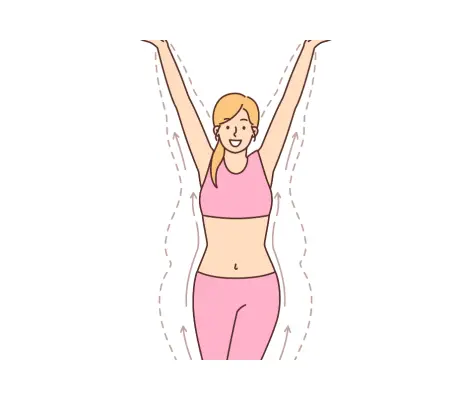
Connect With Others On Their Keto Journey
It’s going to do much good to engage with like-minded individuals, people who are trying to achieve the same goals as you are. People who follow the keto lifestyle can be a great support system. Through them, you can collect valuable insight i nto overcoming obstacles like cravings and other situations that you may otherwise find too daunting.
Last, but not least, monitor your body fat levels, and consider how your body feels. Many find significant health benefits as a result of moving to a low carb diet. These benefits among others are: improved energy levels and better management of type 2 diabetes. If you keep your goals clearly in mind and stay motivated and focused, you could successfully transition to a ketogenic diet.
What Are The Best Foods To Eat On A Keto Diet For Beginners?
The ketogenic diet allows various food choices that foster a successful and nutritious experience. Focusing on high-fat, moderate-protein, and low-carb food selections is essential to maintaining the body’s state of ketosis.
Let’s look at suitable categories, emphasizing whole and unprocessed foods to maximize health benefits and support your weight-loss goals.
Healthy Fats
Fats should be the main pillar of your ketogenic meals. Healthy fats such as avocado oil and olive oil are ideal for cooking and salad dressings. They provide essential nutrients and can assist in burning fat more efficiently.
The healthy fats in nuts and almonds (monounsaturated and polyunsaturated fats) can support weight loss. These fats promote fullness and satiety, which can help reduce overall calorie intake.
Beneficial fats are also found in nuts and seeds alongside their protein content. Regarding snacks, you’d want to pick options like almonds, macadamia nuts, and sunflower seeds to keep your carb intake low.
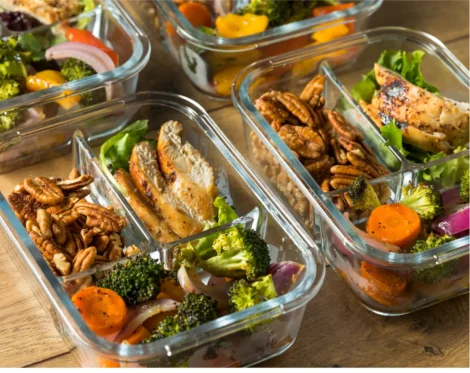
Protein
Protein sources are another vital component of the ketogenic diet. Moderation is advised for protein intake, but focusing on quality is always paramount. Protein intake often includes meats such as beef, pork, chicken, and fish.
Eggs are also prominently listed as an excellent protein choice, providing valuable vitamins and minerals. Tofu and tempeh can serve as alternative protein sources for vegetarians, but be mindful of their carbohydrate content.
Low-carb
Low-carb vegetables like leafy greens, broccoli, cauliflower, and zucchini should be prominent in your meal plan, offering fiber and essential vitamins without spiking insulin levels. These vegetables can be enjoyed raw in salads or cooked as side dishes to complement your main courses.
Lastly, condiments such as mustard and vinegar can touch up the flavor of your meals without adding unnecessary carbs. Keep processed foods at a minimum, and focus on whole, unadulterated options for sustained health benefits.
Lastly, condiments such as mustard and vinegar can touch up the flavor of your meals without adding unnecessary carbs. Keep processed foods at a minimum, and focus on whole, unadulterated options for sustained health benefits. Get some keto cookbooks here with a seven-day meal plan free. Or, get a complete keto beginners’ guide here.
Foods to Avoid on a Ketogenic Diet
Reduce Carbohydrate Intake
What foods should be avoided on a ketogenic diet? The ketogenic diet calls for big changes and a significant reduction in carbohydrates. This shift can drastically alter one’s food choices.
To be successful with the keto lifestyle, it is crucial to identify and avoid specific categories of food that can undermine the process and hinder your progress to achieve ketosis.
A key factor is eliminating high-carb items, sugars, and certain starchy foods that can hinder weight loss and disrupt metabolic processes.

When someone is on a low-carb diet like the keto diet, high-carb traditional staples like bread, pasta, and rice should be completely avoided. These foods boost insulin levels, and that can prevent the body from burning fat for energy.
Individuals on the keto diet are encouraged to incorporate healthy fats, such as avocado oil and olive oil, into their meals because these provide vital nutrients while keeping carb intake low. Additionally, sugary foods and beverages, including sodas and desserts, are detrimental as they can spike blood sugar levels and impede weight loss efforts
Hidden Sugar
Some foods can quietly slip high levels of carbohydrates into your diet. These would directly conflict with the keto diet. Be aware of starchy vegetables like potatoes and corn. They are high carb foods that you should avoid on a keto diet. Get free recipe cookbooks and a seven-day meal plan here.
Processed Foods
You should be especially cautious about processed foods because processed foods contain hidden sugars and additives that would seriously impact your health goals and your diet plan. If you are a beginner, it’s important to understand these food classifications, This could greatly help in creating a meal plan that promotes health benefits while minimizing body fat.
High Sugar Fruits
Some fruits contain a high amount of sugar. For this reason, it’s best to pick fruits that are low in sugar like like berries, like raspberries, strawberries, blackberries, and grapefruit. Even though these are low in sugar, cation and moderation are still called for.
Fruits like grapes, mangoes, and bananas can quickly elevate sugar levels and shoot out of the range of what is acceptable for the keto diet. Fruits like grapes, mangoes, and bananas can quickly elevate sugar levels and shoot out of the range of what is acceptable for the keto diet.
If you avoid these foods and adopt a mindful approach to eating, you can more smoothly and effectively transition into the ketogenic lifestyle and reap its benefits.
How Do I Calculate My Macros For Keto?
Macros refers to the three essential nutrients that the body needs in large amounts.
- Carbohydrates
- Protein
- Fat
You can calculate your macros for a ketogenic diet by following these steps:
1 Use an online calculator to estimate your total daily energy expenditure (TDEE). This should be based on your age, gender, weight, height, and activity level.
2 Set Your Macro Ratios: A typical keto macro ratio is:
- 70-75% of calories from fat
- 20-25% of calories from protein
- 5-10% of calories from carbohydrates

3 Calculate Grams of Each Macro:
- Fat: Multiply your daily calorie intake by 0.70 (for 70%) to get calories from fat, then divide by 9 (calories per gram of fat) to get grams of fat.
- Protein: Multiply your daily calorie intake by 0.20 (for 20%) to get calories from protein, then divide by 4 (calories per gram of protein) to get grams of protein.
- Carbohydrates: Multiply your daily calorie intake by 0.05 (for 5%) to get calories from carbs, then divide by 4 (calories per gram of carbohydrates) to get grams of carbs.
- Adjust Based on Goals: Adjust your macro ratios slightly based on your specific goals, such as weight loss, muscle gain, or maintenance.
Meal Planning
What is a typical keto meal plan for beginners?
You may realize by now that a typical keto meal plan for beginners is high-fat-focused, moderate-protein, and low-carb foods to help the body enter and maintain ketosis. Here’s a sample 7-day plan with meals that fit the ketogenic diet: However, you can also get meal plans and free keto recipes here
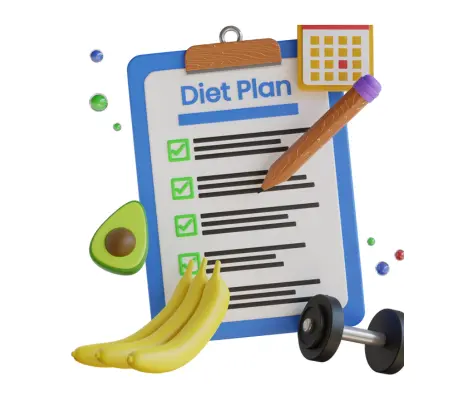
- Breakfast: Scrambled eggs with spinach cooked in butter and avocado slices.
- Lunch: Grilled chicken salad with mixed greens, olive oil, and feta cheese.
- Dinner: Salmon with asparagus and a side of cauliflower mash.
- Breakfast: Chia seed pudding made with unsweetened almond milk and topped with a few berries.
- Lunch: Turkey and cheese lettuce wraps with a side of cucumber slices.
- Dinner: Beef stir-fry with broccoli and bell peppers cooked in coconut oil.
- Breakfast: Keto pancakes made with almond flour, served with sugar-free syrup and a pat of butter.
- Lunch: Cobb salad with boiled eggs, bacon, avocado, and ranch dressing.
- Dinner: Grilled shrimp with zoodles (zucchini noodles) in a garlic butter sauce.
- Breakfast: Greek yogurt (full-fat, unsweetened) with a sprinkle of nuts and seeds.
- Lunch: Cauliflower rice bowl with grilled chicken and avocado.
- Dinner: Pork chops with sautéed spinach and a side salad with vinaigrette.
- Breakfast: Bacon and eggs with a side of sautéed mushrooms.
- Lunch: Tuna salad made with mayo, served in avocado halves.
- Dinner: Keto-friendly meatloaf with steamed green beans.
- Breakfast: Keto smoothie with coconut milk, spinach, avocado, and protein powder.
- Lunch: Zucchini boats stuffed with ground beef and cheese.
- Dinner: Roast chicken with a side of Brussels sprouts roasted in olive oil.
- Breakfast: Omelette with cheese, ham, and bell peppers.
- Lunch: Burger patty with lettuce, tomato, and a side of coleslaw (made with keto-friendly mayo).
- Dinner: Baked cod with lemon butter sauce and a side of sautéed kale.
- Meal Prep: Preparing meals in advance makes it easier to stick to your keto macros.
- Hydration: It’s important to take in plenty of water and stronger sources of electrolytes to prevent the keto flu.
- Read Labels: Be watchful with sauces, dressings, and processed foods as these may contain hidden carbs. Read the labels
Day 1
Day 2
Day 3
Day 4
Day 5
Day 6
Day 7
What Are Some Quick And Easy Keto Recipes?
Keto Diet For Beginners – Easy Recipes
Here are three quick keto recipes for beginners you can complete in very little time. Find more keto meal ideas here.
1 Keto Avocado Egg Salad
- Ingredients: 2 boiled eggs, 1 ripe avocado, lemon juice, salt, and pepper.
- Instructions: Mash the avocado and mix with chopped boiled eggs. Add a squeeze of lemon juice, salt, and pepper to taste. Serve on a bed of lettuce or enjoy as is.
- Ingredients: 1 lb shrimp, 3 cloves garlic (minced), 2 tbsp butter, lemon juice, parsley.
- Instructions: Sauté garlic in butter until fragrant. Add shrimp and cook until pink. Finish with a squeeze of lemon juice and sprinkle with parsley.
2 Garlic Butter Shrimp
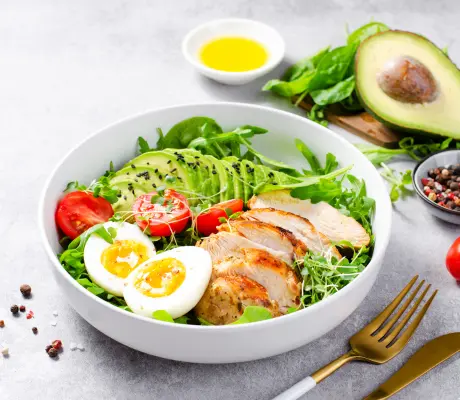
- Ingredients: 2 zucchini (spiralized), 2 tbsp pesto, Parmesan cheese.
- Instructions: Sauté zucchini noodles in a pan for 2-3 minutes. Toss with pesto and top with Parmesan cheese.
3 Zucchini Noodles with Pesto
These simple recipes are perfect for busy individuals and provide what is needed to stay up to speed with your ketogenic lifestyle. For more delicious keto recipes and meal ideas, visit the Customketo website and download free keto recipe books.
Is the ketogenic diet safe for diabetics?
That is a fair question. People with type 2 diabetes can derive great benefits from the keto diet. However, proper guidance is needed. Here are some benefits for diabetics:
- Better Blood Sugar Control: Because the carbohydrate intake is greatly reduced on a keto diet, blood sugar spikes are minimized, which helps stabilize glucose levels.
- Increased Insulin Sensitivity: According to some studies, a ketogenic diet may improve insulin sensitivity, Making it easier for the body to regulate blood sugar levels.
- Weight Loss: Weight management is crucial for people with type 2 diabetes, and the keto diet can be an effective way to lose weight and reduce insulin resistance.
Keto Diet – Benefits for Diabetics
- Hypoglycemia Risk: Significantly lowering carb intake added to medications like insulin or certain oral drugs can lead to low blood sugar (hypoglycemia). It is, therefore, very important to monitor glucose levels closely.
- Ketoacidosis Risk in Type 1 Diabetes: Though this is not too common, people with type 1 diabetes need to be cautious, since the diet can increase the risk of diabetic ketoacidosis (DKA), a dangerous condition.
- Nutrient Deficiencies: Your keto diet may lack essential nutrients like fiber, potassium, and magnesium if it’s not properly planned. These are crucial for good health.
Considerations and Risks:
- Consult Your Doctor: To be on the safe side, talk to your healthcare provider before starting keto, especially if you’re taking insulin or some kind of medication.
- Focus on Nutrient-Dense Foods: Include plenty of non-starchy vegetables, healthy fats (e.g., olive oil, avocado), and quality proteins.
- Monitor Blood Sugar Often: Be sure to check glucose levels regularly with a monitor and adjust medications as needed.
- Stay Hydrated and Monitor Electrolytes: This will help to avoid keto flu symptoms and keep you adequately hydrated.
Safety Tips For for Diabetics On Keto
Can I Follow A Keto Diet While Pregnant?
The ketogenic diet is generally not recommended during pregnancy without careful supervision from a healthcare provider. During pregnancy nutritional needs are greater. This is a time when both the mother and her child need a balanced, nutrient-dense diet. Here are four points to consider about the keto diet if you’re pregnant.
Considerations For Following The Keto Diet While Pregnant:
- Nutritional Needs: A pregnant person needs an adequate intake of essential nutrients like folate, iron, calcium, and fiber. A low-carb diet like the keto diet may limit access to some nutrients if not carefully planned.
- Energy for Fetal Development: Since carbohydrates are a primary energy source for both the mother and the baby, fetal brain development could be seriously affected. This is because a strict ketogenic diet might reduce the available glucose.
- Keto Flu Risks: Common side effects of starting keto, such as fatigue, nausea, and electrolyte imbalances, could overlap with or worsen typical pregnancy symptoms.

- 4 Lack Of Data:
What is known about the safety and effects of the keto diet during pregnancy is limited because of insufficient research. That’s the reason its long-term impact on fetal development remains unclear.
Safe Alternatives To Keto Diet When Pregnant:
If you’re pregnant and considering a low-carb approach, a more moderate plan is a low glycemic index diet. This might be safer. It focuses on whole, unprocessed foods, controlled carb intake, and avoiding blood sugar spikes without entering ketosis.
keto Diet For Beginners – Risks Or Side Effects
It is advisable to get sound guidance before starting the ketogenic diet. Not following the diet properly can lead to risks and side effects. Let’s have a look at some of the long term and short term effects.
- Keto Flu: It’s common to experience symptoms like fatigue, headaches, nausea, dizziness, and irritability within the first week of starting the keto diet as the body deals with the change of burning fat for energy instead of carbohydrates.
- Dehydration and Electrolyte Imbalance: The reduction in carbs leads to water loss and depletion of electrolytes like sodium, potassium, and magnesium. This could cause cramps, dizziness, or fatigue.
- Digestive Issues: A sudden change in diet may lead to constipation or diarrhea due to lower fiber intake or changes in gut bacteria.
Keto Diet For Beginners – Short-Term Effects
To help you deal with digestive issues on the keto diet, use probiotic-rich foods like kimchi, sauerkraut, and unsweetened yogurt. Probiotic supplements can also be helpful.
- Nutrient Deficiencies: The diet needs to be well-balanced with vegetables and supplements. If not, it could lack certain essential nutrients like fiber, vitamins (e.g., vitamin C), and minerals.
- Bone Health Issues: Prolonged ketosis may lead to bone density loss due to changes in mineral metabolism.
- Potential Liver and Kidney Strain: High fat and protein intake can put extra strain on the liver and kidneys, particularly for people with pre-existing conditions.
- Increased Cholesterol Levels: While many people see improved cholesterol profiles, some may
Keto Diet For Beginners – Long-Term Risks
These are some of the long-term risks that beginners to the keto diet should know.
- Stay Hydrated: Drink plenty of water and replenish electrolytes.
- Eat Nutrient-Dense Foods: Focus on non-starchy vegetables, healthy fats, and quality proteins.
- Monitor Health: Regularly check cholesterol, kidney function, and overall health with your healthcare provider.
Tips to Minimize Risks:
Keto Diet For Beginners – Mistakes to Avoid
Failing To Track Carb Intake
Keto diet for beginners could be a transformative experience, yet many beginners often encounter common pitfalls that hold them back. One significant mistake is underestimating carb intake. The ketogenic diet emphasizes a low carb consumption, generally limiting daily intake to around 20 to 50 grams.
If you fail to track your carbs intake accurately, this can inadvertently lead to exceeding this limit. This, in turn, may impede the body’s transition into a state of ketosis. Utilizing food-tracking apps can aid in monitoring carb intake effectively.
Not Consuming Enough Fat
Inadequate fat intake is another mistake beginners to the keto diet make. A core principle of the keto diet is replacing the calories lost from reducing carbohydrates with healthy fats. Those new to this dietary approach may be tempted to choose low-calorie alternatives instead.
However, consuming healthy fats such as avocado oil and olive oil is crucial for providing the body with the necessary fuel. Understanding the role of fat in energy is essential for maintaining satiety and reaching weight loss goals.
Not Replenishing Electrolytes
Additionally, neglecting electrolyte balance can also be detrimental. As mentioned earlier, the initial stages of a keto diet can lead to rapid fluid loss, often resulting in imbalances of electrolytes such as sodium, potassium, and magnesium.
This imbalance might lead to symptoms similar to the “keto flu,” including fatigue and headaches. To address this, incorporate electrolyte-rich foods and consider supplementation as necessary.
Not Balancing Protein And Fat

Last, but not least, beginners to the keto diet may overlook the importance of adequate protein intake while focusing primarily on fats. A keto diet meal plan is lower in protein than traditional low-carb diets, but protein plays a crucial role in preserving muscle mass during weight loss.
Beginners should aim for a balanced approach by adjusting their meal plans with the right proportions of fats, proteins, and limited carbs. Get a custom-made meal plan
If you recognize and avoid these common mistakes beginners make, it can significantly enhance your keto journey, and you’ll be in a much better position to reap the health benefits associated with the ketogenic lifestyle.
How to Monitor Your Progress on the Keto Diet For Beginners
Key Areas To Track For Progress
The keto diet for beginners has rewards and challenges for those disciplined enough to follow and stick to the routine. One of the crucial components of this process is monitoring your progress effectively. To be successful, a ketogenic diet involves tracking various metrics beyond just weight loss. Key areas to focus on include body measurements, ketone levels, and overall health benefits.
Weight Loss Progress
You can start by regularly assessing your weight using a digital scale. While weight can indicate progress, it’s not the only sign you’re going places. Some people experience fluctuations due to changes in water retention, particularly in the initial stages of the low-carb diet.
It’s better to look at body measurements—such as waist, hips, and thighs. This will give you a more comprehensive understanding of your body’s transformation.
Tracking Ketone Levels
Testing your ketone levels is another important method of monitoring progress on the keto diet. Several tools are available to help you do that. They include urine test strips, breath analyzers, and blood ketone meters. These devices will help you determine whether you’ve reached and maintained a state of ketosis.
If yes, this indicates that your body is burning fat for energy. Monitoring these levels could give you valuable insight into how your body responds to different keto meals and your overall carb intake.
Track Ketone Levels With Mobile Apps
There are mobile apps specifically designed to track progress on ketogenic diets. These can simplify the way you monitor your progress. These apps can help you log food consumption and protein intake. This makes it easier to stick to your meal plan, not falling under or going above. You’ll also see how your body reacts to the foods you consume.
Set small goals and short-term milestones like achieving specific measurements or improving energy levels. Seeing these little changes can be encouraging and signify the effectiveness of the diet.
Other Areas To Assess When On A Keto Diet For Beginners
Once again, you don’t want to only look at how much weight you’ve lost to determine progress. How about improved blood pressure enhanced mental clarity, and a decrease in cravings for processed foods? Look at these areas too. Keep a holistic approach to monitoring and position yourself on the ketogenic diet.
Keto Diet For Beginners – Dealing With Keto Flu
One of the primary reasons individuals encounter these symptoms is the rapid loss of stored carbohydrates, or glycogen, along with water weight. Since glycogen is connected to water retention, its depletion significantly decreases overall water volume in the body. This change can cause dehydration.
Keto Diet For Beginners – Minimizeing Or Avoiding Keto Flu
If you’re on a keto diet for beginners, following these seven points will help you minimize or avoid keto flu.
- Gradual Transition: Instead of jumping straight into a strict keto diet, gradually reduce your carbohydrate intake over a period of time. This allows your body to adapt to burning fat for fuel without going into shock. Get a custom keto meal plan for beginners.
- Stay Hydrated: Your body loses water more quickly when you lower your carb intake. The result is dehydration. Solution? drink plenty of water throughout the day to stay hydrated. You should also drink electrolyte-rich drinks or take an electrolyte supplement to replace sodium, potassium, and magnesium.
- Increase Salt Intake: As your insulin levels drop, your body excretes more salt. Adding a little extra salt to your food or drinking bone broth can help keep your sodium levels balanced and prevent headaches, fatigue, or muscle cramps.
- Eat Enough Fat: On a keto diet for beginners, it’s important to ensure you’re eating enough healthy fats because if you’re not, your body might struggle to adjust to using fat for fuel. That could lead to fatigue and other keto flu symptoms.
- Get Plenty of Sleep: When starting a keto diet for beginners, remember that the body goes through a transition phase. During that time, you’ll need extra rest. So, get enough sleep to help your body adjust and repair.
- Consider MCT Oil: Medium-chain triglyceride (MCT) oil can be a quick source of energy on keto and may help ease the transition. It’s absorbed quickly and used for energy, so it might help combat feelings of fatigue.
- Stay Active: Light physical activity, like walking or other physical activities, can help you adjust faster and reduce keto flu symptoms. But avoid intense exercise during the first few days until you feel more comfortable on the keto diet for beginners.
Final Thoughts and Getting Started on Your Keto Journey
The ketogenic diet, characterized by a low carb intake and high fat consumption, has gained popularity for its effectiveness in promoting weight loss and other health benefits. By significantly reducing carbohydrates and increasing healthy fats like avocado oil and olive oil, individuals can achieve a state of ketosis, where the body burns fat for energy instead of relying on glucose from carbs. This metabolic shift can lead to lower body fat, improved insulin levels, and even better management of blood pressure.
As you embark on your keto journey, it is essential to familiarize yourself with various keto meals and recipes. A well-structured meal plan tailored to your dietary preferences can make sticking to this low carb diet much more manageable. For beginners, understanding the basics of protein intake, the importance of healthy fats, and how to track carb intake can significantly ease the transition into this lifestyle. To get you started, consider resources such as a keto diet for beginners book, which can provide comprehensive guidance on how to start the keto diet for weight loss effectively.
It is also advisable to stay aware of the potential keto diet side effects, as adjusting your diet might initially come with challenges. Being prepared with knowledge about transitioning smoothly can enhance your success. Determine your personal goals, whether it is to lose weight or maintain health, and adapt your approach as needed. Engaging with communities and forums focused on keto can provide you with additional insights and motivation.
We encourage you to download our guides that delve deeper into the benefits of the keto diet and offer practical strategies on meal prepping. Taking the first step can seem daunting, but remember that each meal is an opportunity to nourish your body and support your wellness journey.